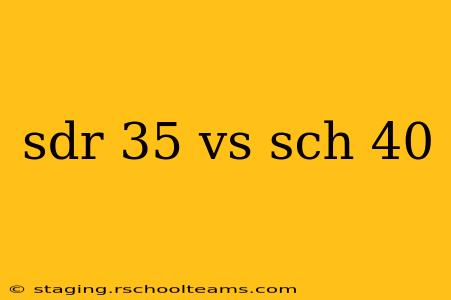Choosing the right pipe for your project requires careful consideration of various factors, including pressure ratings, material compatibility, and cost. Two common standards frequently encountered are SDR 35 and SCH 40. While both refer to the dimensions and pressure ratings of plastic pipes (typically PVC or CPVC), they represent different approaches to specifying these crucial parameters. This comprehensive guide will clarify the key distinctions between SDR 35 and SCH 40 piping, helping you make informed decisions for your specific application.
What Does SDR Mean?
SDR stands for Standard Dimension Ratio. It's a dimensionless number calculated by dividing the outside diameter of the pipe by the wall thickness. A lower SDR value indicates a thicker wall, resulting in higher pressure resistance.
What Does SCH 40 Mean?
SCH 40 refers to Schedule 40, a designation from the American National Standards Institute (ANSI) and the American Society of Mechanical Engineers (ASME) that specifies the wall thickness of metallic pipes. While it's primarily used for metal pipes, the term is sometimes loosely applied to plastic pipes, often resulting in confusion.
SDR 35 vs. SCH 40: Key Differences
The core difference lies in how the pipe's pressure rating is determined:
- SDR 35: Uses the SDR calculation directly to define the wall thickness and subsequent pressure capabilities. This method focuses on the ratio between the pipe's outer diameter and wall thickness.
- SCH 40: Specifies the minimum wall thickness according to a set of standards. This system is more directly related to the absolute wall thickness, which in turn dictates the pressure capabilities.
This difference means that a "SCH 40" plastic pipe might not be directly comparable to a "SCH 40" metal pipe in terms of pressure ratings. The pressure handling capabilities are influenced by the material properties of the pipe (PVC, CPVC, steel, etc.)
Practical Implications:
- Pressure Resistance: Generally, SDR 35 pipes with the same outer diameter will have thinner walls than SCH 40 pipes, resulting in lower pressure ratings. SCH 40 is typically designed for higher pressures.
- Cost: SDR 35 pipes are usually less expensive due to their thinner walls and reduced material usage.
- Applications: SDR 35 is often suitable for lower-pressure applications like irrigation, drainage, or certain non-pressure applications. SCH 40 is generally preferred for higher-pressure systems, such as water distribution or industrial processes.
- Weight: SDR 35 pipes are lighter and easier to handle and install than SCH 40 pipes.
Which One Should I Choose?
The best choice depends entirely on your specific project needs. Consider these questions:
- What is the required pressure rating for the system? Consult relevant pressure rating charts for both SDR 35 and SCH 40 pipes made from your chosen material (PVC, CPVC, etc.).
- What is the application? Lower-pressure applications may favor SDR 35 due to its cost-effectiveness.
- What is the budget? SDR 35 is usually the more economical option.
- What material is being used? The material properties significantly impact the overall performance of the pipe, regardless of the SDR or SCH rating.
Frequently Asked Questions
Is SCH 40 stronger than SDR 35?
Generally yes, assuming we're comparing pipes of the same nominal diameter and made of the same material. SCH 40 typically has a thicker wall, leading to higher pressure resistance and overall strength. However, the material itself significantly influences the final strength.
What is the difference between SDR and schedule pipe?
SDR is a dimension ratio used mainly for plastic pipes, while schedule is primarily used for metallic pipes. Schedule directly specifies the minimum wall thickness, whereas SDR relates the outer diameter to the wall thickness. Direct comparison between SDR and schedule ratings can be tricky, and you should always consult manufacturer specifications.
Can I use SDR 35 for potable water?
Yes, SDR 35 PVC and CPVC pipes are commonly used in potable water systems, provided they meet all relevant health and safety regulations. Always check with local codes and use pipes certified for potable water applications.
This guide provides a comprehensive overview of SDR 35 and SCH 40 pipe distinctions. Remember to always consult the manufacturer's specifications and relevant building codes before selecting piping for your project. Using the incorrect pipe can lead to system failure, leaks, and other serious problems.
